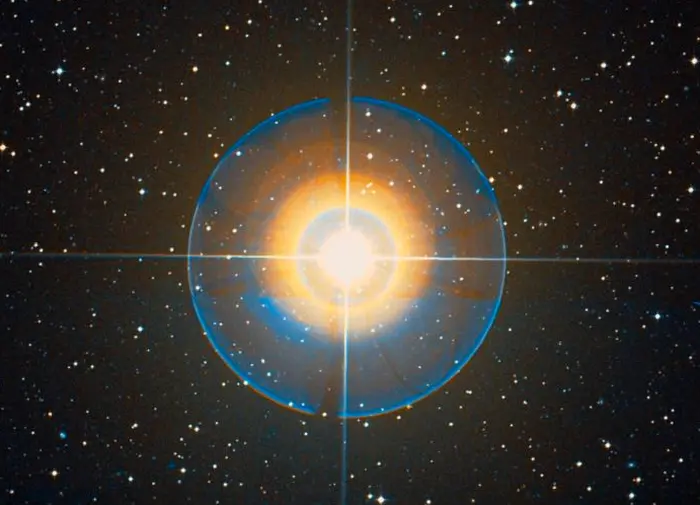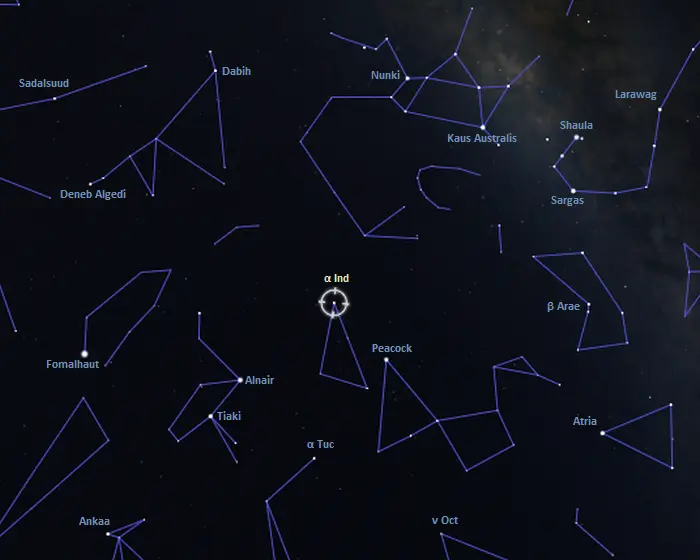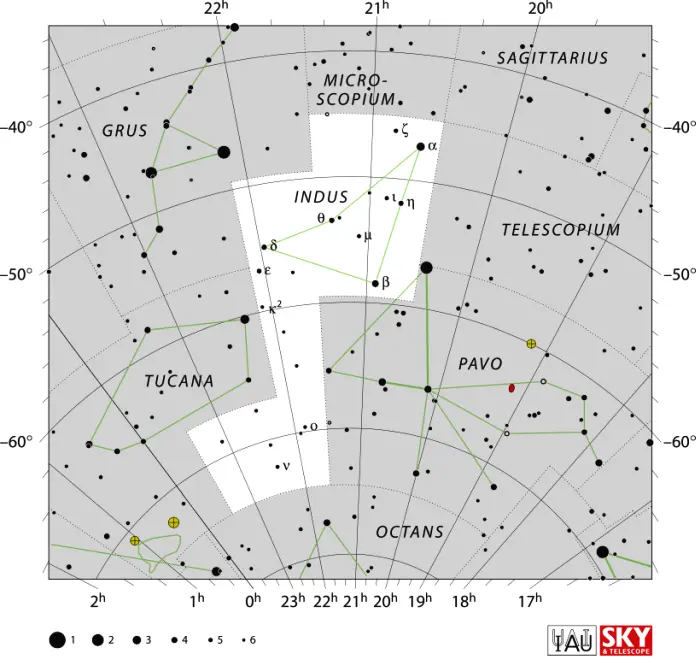Alpha Indi (α Ind) is an evolved K-type star located 99.1 light-years away in the southern constellation of Indus. The star was traditionally known as the Persian. It is much larger and more luminous than the Sun. With an apparent magnitude of 3.11, it is the brightest star in Indus.
Star type
Alpha Indi has the stellar classification K0 III-IV, indicating an orange giant or subgiant star. The evolved star has a mass of 1.879 solar masses and has expanded to a size of 9.706 solar radii as it evolved away from the main sequence. With a surface temperature of 4,896 K, it is 59 times more luminous than the Sun. The star is much younger than the Sun, with an estimated age of 1.572 billion years.
Alpha Indi has two optical companions, 12th and 13th magnitude stars, at a separation of at least 2,000 astronomical units. The companions are believed to be red dwarfs. If they form a physical star system with α Indi, they have an orbital period of at least 50,000 years.

Alpha Indi (the Persian), image: Wikisky (DSS2)
Facts
With a visual magnitude of 3.11, Alpha Indi is on average the 192nd brightest star in the sky. It is about as bright as Lambda Centauri in the constellation Centaurus, Wazn (Beta Columbae) in Columba, and Talitha (Iota Ursae Majoris) in Ursa Major. The Persian is the only star in Indus that makes the list of the 300 brightest stars in the sky.
In traditional Chinese astronomy, Alpha Indi was known as 波斯二 (Bō Sī èr), the Second Star of Persia. In China, the star is called Pe Sze, the Persian. Stars in the region of the southern celestial pole were catalogued in the early 17th century, after the arrival of western star maps. Persia was one of the 23 asterisms added when the Chongzhen calendar was compiled by Chinese astronomer Xu Guangqi (Paul Siu) with the assistance of Jesuit scholars.
Name
Alpha Indi does not have a proper name that is formally approved by the International Astronomical Union (IAU). The star was historically known as the Persian. It was given this name by Jesuit missionaries, but the meaning is uncertain.
The star is most commonly referred to by its Bayer designation, Alpha Indi. It is catalogued as HD 196171 in the Henry Draper Catalogue, HR 7869 in the Yale Bright Star Catalogue, and HIP 101772 in the Hipparcos catalogue.
Location
Alpha Indi lies in the region between Sagittarius and the Southern Birds (the constellations Pavo, Grus, Tucana, and Phoenix). It forms a quadrangle with Alnair, the brightest star in Grus (the Crane), Alpha Tucanae in Tucana (the Toucan), and Peacock in Pavo (the Peacock). The northern vertex of the quadrangle points towards the feet of Sagittarius.

The location of Alpha Indi, image: Stellarium
Constellation
Alpha Indi is located in the constellation Indus. Located in the far southern sky, Indus is largely invisible to most observers in the northern hemisphere. It is one of the constellations charted by Dutch explorers in the late 16th century and included on a celestial globe designed by the Dutch-Flemish astronomer and cartographer Petrus Plancius in 1597 or 1598.
Like many southern constellations, Indus does not have any exceptionally bright stars and it does not stand out in the sky. The constellation contains only two stars brighter than magnitude 4.0, the orange giants Alpha and Beta Indi. It is only the 49th largest constellation in the sky, stretching across 294 square degrees.
Other notable stars in Indus include the orange dwarf Epsilon Indi, one of the nearest visible stars to the Sun, the multiple star Theta Indi, the semiregular variable red giant star T Indi, the binary star Delta Indi, and the orange giants Zeta Indi, Mu Indi and HD 207229, the last of which has an orbiting planet.

Indus constellation map by IAU and Sky & Telescope magazine (Roger Sinnott & Rick Fienberg) (CC BY 3.0)
Indus contains many galaxies. It hosts the Pavo-Indus Supercluster of galaxies, along with the constellations Pavo and Telescopium. The relatively bright galaxies in Indus include the lenticular galaxies NGC 7041 and NGC 7049, the spiral galaxies NGC 7090, NGC 7083, NGC 7038, and NGC 7124, and the elliptical galaxies NGC 7029 and NGC 7196.
The best time of the year to see the stars and deep sky objects in Indus is during the month of September, when the constellation appears higher above the horizon in the early evening. The entire constellation is visible from locations south of the latitude 15° N.
The 10 brightest stars in Indus are Alpha Indi (mag. 3.11), Beta Indi (mag. 3.67), Theta Indi (mag. 4.40), Delta Indi (mag. 4.40), Eta Indi (mag. 4.52), Epsilon Indi (mag. 4.8310), Zeta Indi (mag. 4.90), Iota Indi (mag. 5.06), Mu Indi (mag. 5.17), and Nu Indi (mag. 5.28).
Alpha Indi
| Spectral class | K0 III–IV |
| U-B colour index | +0.79 |
| B-V colour index | +1.00 |
| Apparent magnitude | 3.11 |
| Absolute magnitude | 0.65 |
| Distance | 99.1 ± 0.7 light years (30.4 ± 0.2 parsecs) |
| Parallax | 32.8989 ± 0.2225 mas |
| Radial velocity | −1.3 ± 0.6 km/s |
| Proper motion | RA: +50.922 ± 0.201 mas/yr |
| Dec.: +66.026 ± 0.188 mas/yr | |
| Mass | 1.879 ± 0.13 M☉ |
| Luminosity | 59 L☉ |
| Radius | 9.706 ± 0.294 R☉ |
| Temperature | 4,896 ± 34 K |
| Metallicity | −0.05 ± 0.03 dex |
| Age | 1.572 ± 0.273 billion years |
| Surface gravity | 2.96 ± 0.1 cgs |
| Constellation | Indus |
| Right ascension | 20h 37m 34.0321723878s |
| Declination | –47° 17′ 29.405217299″ |
| Names and designations | Alpha Indi, α Indi, α Ind, HD 196171, HR 7869, HIP 101772, FK5 769, SAO 230300, GJ 9700, GJ 794.1, CD −47 13477, CPD-47 9537, GC 28682, GCRV 12888, PLX 4897.00, PPM 326349, UBV 17857, UBV M 24983, CPC 0 18902, TD1 26970, TIC 91048865, GSC 08411-01822, WEB 18387, JP11 3255, N30 4550, SKY# 39054, IRAS 20340-4728, 2MASS J20373402-4717292, TYC 8411-1822-1, Gaia DR2 6674382927491854848, Gaia DR3 6674382927491854848, CCDM J20376-4717A, IDS 20305-4738 A, WDS J20376-4717A |